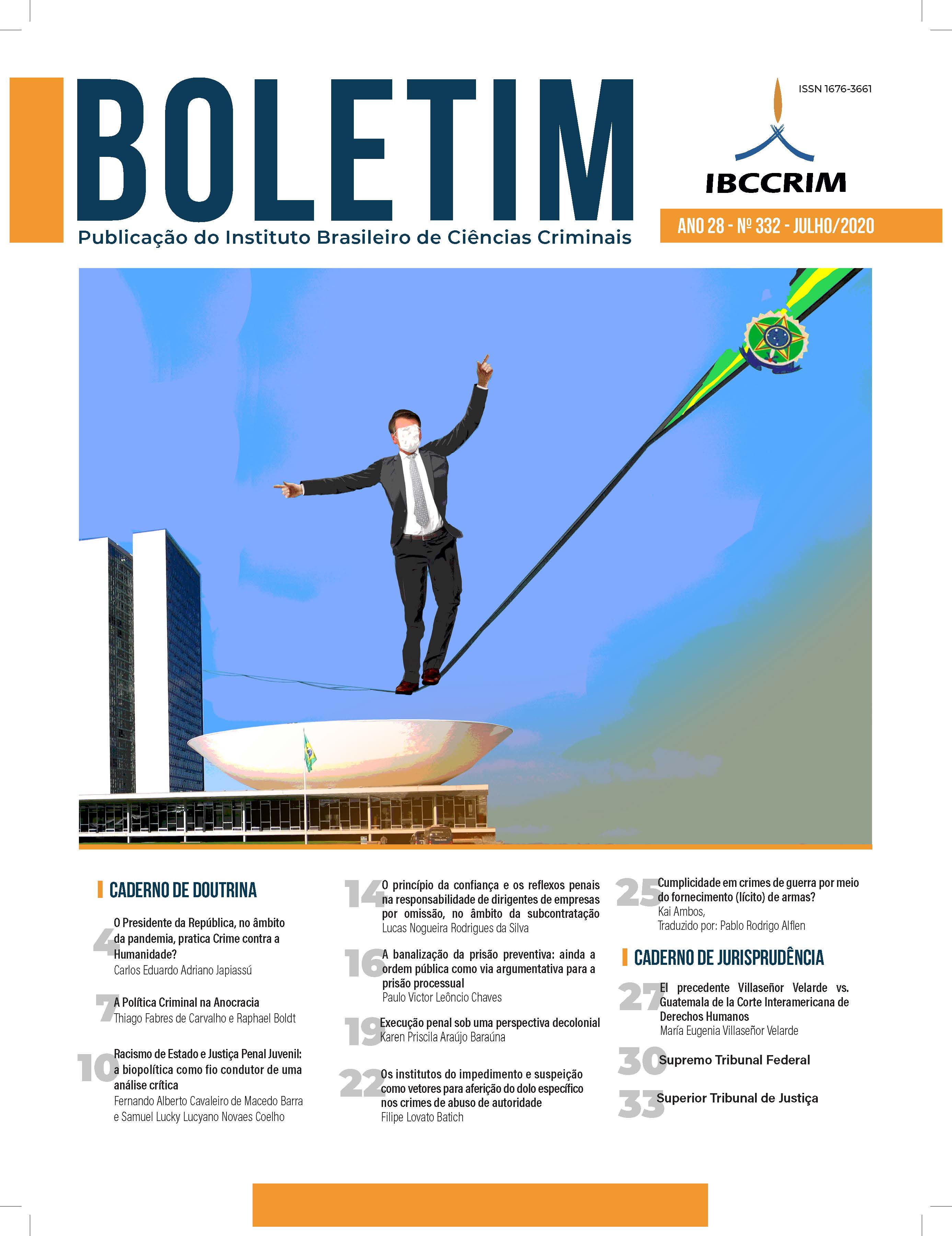The trivialisation of pre-trial detention: again, public order as an argumentative route to procedural detention
Views: 187Keywords:
Discourse analysis onto judicial decisions, Re-trial detentions, Mass imprisionmentAbstract
Official data towards the profile of prison population in Brazil state more than 40% of it is composed of non-convicted people, which leads us to question the acting of judiciary branch, as being, at the same time, the biggest responsible and the most silent of the government branches. The discourse analysis onto the judicial decisions shows the prevalence of pre-trial detentions based on the provision of public order, and, considering it as the least convincing reason, it shows us more the profile of the judges than the profile of those people chosen by the criminal system.
Downloads
Publication Facts
Reviewer profiles N/A
Author statements
- Academic society
- Instituto Brasileiro de Ciências Criminais
- Publisher
- IBCCRIM
References
ANDRADE, V. R. P. A ilusão de segurança jurídica: do controle da violência à violência do controle penal. Porto Alegre: Livraria do Advogado, 1997.
BARRETO, A. L. L. A. Cautelaridade penal ou controle social? Um olhar crítico sobre as prisões cautelares no Brasil. Panóptica, v.. 11, n. 1, p. 184-210, jan./jun. 2016.
BATISTA, N. Introdução crítica ao direito penal brasileiro. 12. ed. rev. e. atual. Rio de Janeiro: Revan, 2011.
BATISTA, V. M. Introdução crítica à criminologia brasileira. Rio de Janeiro: Revan, 2011.
BITENCOURT, C. R. Tratado de direito penal: parte geral. 21. ed. rev, ampl. e. atual. São Paulo: Saraiva, 2015.
BNMP 2.0. Banco nacional de monitoramento de prisões: cadastro nacional de presos. Conselho Nacional de Justiça. Brasília, 2018.
BOTTINI, P. C. Medidas cautelares penais (Lei 12.403/11): novas regras para a prisão preventiva e outras polêmicas. Revista Eletrônica de Direito Penal AIDP-GB, v. 1, n. 1, jun. 2013.
DROIT, R.-P. (ed.). Dos suplícios às celas. In: MOTTA, Manoel Barros da (org.). Michel Foucault - Ditos & Escritos VIII: segurança, penalidade e prisão. Rio de Janeiro: Forense Universitária, 2012. Cap. 10. p. 32-36. Entrevista concedida a R.-P Droit e publicada no jornal Le Monde, em 21 de fevereiro de 1975, p. 16.
FOUCAULT, Michel. Vigiar e punir: nascimento da prisão. Tradução de Raquel Ramalhete. 42. ed. Petrópolis, RJ: Vozes, 2014. 302 p.
GARLAND, D. Mass imprisonment: social causes and consequences. London: Sage Publications, 2001.
LIMA, R. B. Manual de processo penal. v. único. 7. ed. rev., ampl. e atual. Salvador: JusPodivm, 2019.
GEOPRESÍDIOS. Dados nas inspeções dos estabelecimentos penais. Conselho Nacional de Justiça. Disponível em: http://www.cnj.jus.br/inspecao_penal/mapa.php. Acesso em 28.11.2018.
INFOPEN. Levantamento nacional de informações penitenciárias: Atualização – junho de 2016. Brasília, Ministério da Justiça e Segurança Pública. Departamento Penitenciário Nacional, 2017.
LOPES JÚNIOR. A. C. C. Direito processual penal. 15. ed. São Paulo: Saraiva Educação, 2018.
LYRA FILHO, R. O que é direito. 11. ed.. São Paulo: Brasiliense, 1982.
PRADO, G. Sistema acusatório: a conformidade constitucional das leis processuais penais. 3. ed. Rio de Janeiro: Editora Lumen Juris, 2005.
SANGUINÉ, O. Prisão cautelar, medidas alternativas e direitos fundamentais. Rio de Janeiro: Forense, 2014.
TOURINHO FILHO, F. C. Processo penal. v. 3. 35. ed. rev. e. atual. São Paulo: Saraiva, 2013.
WORLD PRISON BRIEF. World prison population list. 11. ed. Institute for Criminal Policy Research, 2015. Disponível em: http://www.prisonstudies.org/sites/default/files/resources/downloads/world_prison_population_list_11th_edition_0.pdf. Acesso em: 10 jan. 2019.
Downloads
Published
How to Cite
Issue
Section
License
Copyright of published articles belongs to the author, but with journal rights over the first publication and respecting the one-year exclusivity period. Authors may only use the same results in other publications by clearly indicating this journal as the medium of the original publication. If there is no such indication, it will be considered a situation of self-plagiarism.
Therefore, the reproduction, total or partial, of the articles published here is subject to the express mention of the origin of its publication in this journal, citing the volume and number of this publication. For legal purposes, the source of the original publication must be consigned, in addition to the DOI link for cross-reference (if any).


 Português (Brasil)
Português (Brasil)
 English
English
 Español (España)
Español (España)






